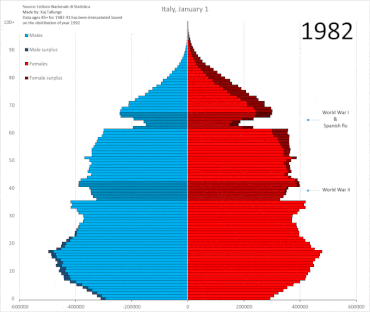Our website is made possible by displaying online advertisements to our visitors.
Please consider supporting us by disabling your ad blocker.
Demographics of Italy
| Demographics of Italy | |
|---|---|
 Population pyramid of Italy as of 2022 | |
| Population | |
| Growth rate | |
| Birth rate | |
| Death rate | |
| Life expectancy | |
| • male | |
| • female | |
| Fertility rate | |
| Infant mortality rate | |
| Net migration rate | |
| Age structure | |
| 0–14 years | |
| 15–64 years | |
| 65 and over | |
| Nationality | |
| Nationality | noun: Italian(s) adjective: Italian |
| Major ethnic | Italians |
| Minor ethnic | |
| Language | |
| Official | Italian |
| Spoken | Languages of Italy |

Demographic features of the population of Italy include population density, ethnicity, education level, health of the populace, economic status, religious affiliations and other aspects.
At the beginning of 2024, Italy had an estimated population of 58.9 million. Its population density, at 195.7 inhabitants per square kilometre (507/sq mi), is higher than that of most Western European countries. However, the distribution of the population is very uneven: the most densely populated areas are the Po Valley (with about a third of the country's population) in northern Italy and the metropolitan areas of Rome and Naples in central and southern Italy, while large rural areas are very sparsely populated, like the plateaus of Basilicata, the Alps and Apennines highlands, and the island of Sardinia.
The population of the country almost doubled during the 20th century, but the pattern of growth was extremely uneven due to large-scale internal migration from the rural South to the industrial cities of the North, due to the Italian economic miracle of the 1950s and 1960s. In addition, after centuries of net emigration, since the 1980s Italy has experienced large-scale immigration for the first time in modern history. Italian government data, in its annual report for 2019, estimated the number of foreign nationals residing within Italy, including immigrants, at about 5.234 million.[3] Due to such large-scale immigration to the country, particularly from the early 2000s to 2014, the population peaked at 60.79 million. Since then, decreasing migration, a continuously falling birth rate, and continuous aging have led to a sharp decrease in the Italian population.
High fertility and birth rates persisted until the 1970s, after which they started to dramatically decline, leading to rapid population aging. At the end of the 2000s decade, one in five Italians was over 65 years old.[4] Italy experienced a short-term growth in birth rates.[5] The total fertility rate temporarily rose from an all-time low of 1.18 children per woman in 1995 to 1.46 in 2010.[6] Since then, fertility rates have resumed their decline, to reach a low of 1.24 in 2022.[7]
Since the revision of the Lateran Treaty in 1984, Italy has no official religion, although it continues to recognize the role the Catholic Church plays in Italian society. In 2017, 78% of the population identified as Catholic, 15% as non-believers or atheists, 2% as other Christians and 6% adhered to other religions.[8]
- ^ "Istat: Bilancio demografico Mensile".
- ^ "La mortalità in Italia sotto i 5 anni: aggiornamento dei dati per causa, territorio e cittadinanza". Istat.it. Istat. 18 October 2018. Retrieved 15 May 2021.
- ^ "Tendenze demografiche" (PDF). istat.it (in Italian). Retrieved 11 November 2023.
- ^ EUROSTAT. "Ageing characterises the demographic perspectives of the European societies – Issue number 72/2008" (PDF). Archived from the original (PDF) on 2 January 2009. Retrieved 28 April 2009.
- ^ ISTAT. "Crude birth rates, mortality rates and marriage rates 2005–2008" (PDF) (in Italian). Archived from the original (PDF) on 10 August 2011. Retrieved 10 May 2009.
- ^ ISTAT. "Average number of children born per woman 2005–2008" (PDF) (in Italian). Archived from the original (PDF) on 10 August 2011. Retrieved 3 May 2009.
- ^ "Births in Italy heading for new record low in 2023 - stats office". reuters. Retrieved 3 January 2024.
- ^ "Being Christian in Western Europe" (PDF). Pew Research Center. 2018. p. 22. Archived from the original (PDF) on 2 August 2019. Retrieved 5 January 2020.
Previous Page Next Page


